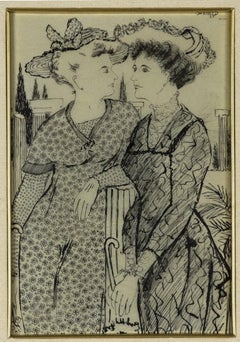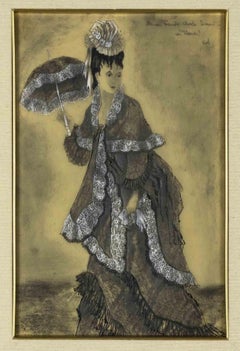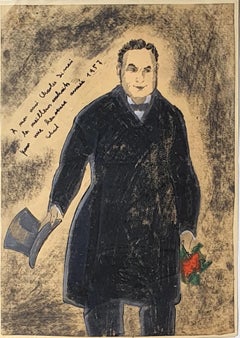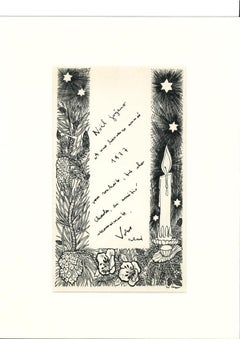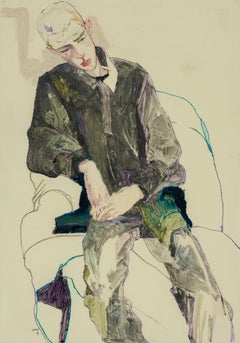Erhard Klepper Drawings and Watercolor Paintings
to
1
10
10
8
2
Overall Height
to
Overall Width
to
6
9
7
5
3
2
2
2
1
1
1
1
1
1
1
1
1
10
5
3
10
706
412
288
228
6
5
5
2
1
Artist: Erhard Klepper
A couple - Original drawing in china ink on paper by Erhard Klepper - 1956
By Erhard Klepper
Located in Roma, IT
A couple is an original drawing in china ink on paper realized in 1956 by Erhard Klepper (1906-1980).
Hand-signed and dated on the higher margin
The state of preservation is good ...
Category
1950s Modern Erhard Klepper Drawings and Watercolor Paintings
Materials
Ink
Girls - China Ink on Paper by Erhard Klepper - Mid-20th Century
By Erhard Klepper
Located in Roma, IT
Girls is an original artwork realized by Erhard Klepper in the early 20th Century.
Original black and white china ink drawing.
The artwork repr...
Category
Early 20th Century Modern Erhard Klepper Drawings and Watercolor Paintings
Materials
Ink
Girls - China Ink on Paper by Erhard Klepper - Mid-20th Century
By Erhard Klepper
Located in Roma, IT
Girls is an original artwork realized by Erhard Klepper in the early 20th Century.
Original black and white china ink drawing.
The artwork repr...
Category
Early 20th Century Modern Erhard Klepper Drawings and Watercolor Paintings
Materials
Ink
Noble Woman - Drawing by E. Klepper - 1948
By Erhard Klepper
Located in Roma, IT
Noble Woman is an original drawing on paper realized by Erhard Klepper (1906-1980) in 1948.
Mixed media: drawing and watercolor. Hand-written notes on the higher right margin. The a...
Category
1940s Modern Erhard Klepper Drawings and Watercolor Paintings
Materials
Mixed Media
Portrait - Pastel and Watercolor Drawing by E. Klepper - 1957
By Erhard Klepper
Located in Roma, IT
Portrait is an original drawing in pastel and watercolor on paper realized in 1957 by Erhard Klepper (1906-1980). with the inscription of the artist beside the drawing of man.
The s...
Category
1950s Erhard Klepper Drawings and Watercolor Paintings
Materials
Watercolor, Pastel
Christmas Greeting Card - Original Ink by Erhard Klepper - 20th Century
By Erhard Klepper
Located in Roma, IT
Christmas Greeting Card is an original drawing in china ink on paper realized by Erhard Klepper (1906-1980).
Hand-signed on the lower right.
The state of preservation is very good....
Category
1940s Erhard Klepper Drawings and Watercolor Paintings
Materials
Ink
The Letter - China Ink and Watercolor Drawing by E. Klepper - 1950s
By Erhard Klepper
Located in Roma, IT
The Letter is an original drawing in china ink and watercolor on paper realized by Erhard Klepper(1906-1980). hand-signed on the top left.
The state of preservation is very good.
S...
Category
1950s Modern Erhard Klepper Drawings and Watercolor Paintings
Materials
Watercolor, Ink
Hopeless - China Ink and Watercolor Drawing by E. Klepper - 1948
By Erhard Klepper
Located in Roma, IT
Hopeless is an original drawing in china ink on paper realized in 1948 by Erhard Klepper(1906-1980). hand-signed on the lower left and dated.
The state of preservation is good with ...
Category
1940s Modern Erhard Klepper Drawings and Watercolor Paintings
Materials
Ink, Watercolor
Erhard Klepper Watercolor Gouache Painting "Damen in Ballroben", 1947
By Erhard Klepper
Located in Berlin, DE
Watercolor, gouache on paper, 1947. Signed and dated left in the top. Framed.
Dimensions: 19.49 x 14.57 in ( 49,5 x 37 cm ), Framed: 23.15 x 18.62 in ( 58,8 x 47,3 cm )
Erhard Klepper ( 1906-1980 ) He was a German painter, draftsman, print maker...
Category
1940s Realist Erhard Klepper Drawings and Watercolor Paintings
Materials
Watercolor, Gouache
Erhard Klepper Watercolor Gouache Painting " In Begleitung", 1948
By Erhard Klepper
Located in Berlin, DE
Watercolor, gouache on paper, 1948. Signed and dated left in the top. Framed.
Dimensions: 14.96 x 11.81 in ( 38 x 30 cm ), framed: 19.09 x 15.67 in ( 48,5 x 39,8 cm )
Erhard Klepper...
Category
1940s Realist Erhard Klepper Drawings and Watercolor Paintings
Materials
Watercolor, Gouache
Related Items
The Abduction of the Sabine Women , a Renaissance drawing by Biagio Pupini
Located in PARIS, FR
This vigorous drawing has long been attributed to Polidoro da Caravaggio: The Abduction of the Sabine Women is one of the scenes that Polidoro depicted between 1525 and 1527 on the façade of the Milesi Palazzo in Rome. However, the proximity to another drawing inspired by this same façade, kept at the Ecole des Beaux-Arts, and to other drawings inspired by Polidoro kept at the Musée du Louvre, leads us to propose an attribution to Biagio Pupini, a Bolognese artist whose life remains barely known, despite the abundant number of drawings attributed to him.
1. Biagio Pupini, a Bolognese artist in the light of the Roman Renaissance
The early life of Biagio Pupini, an important figure of the first half of the Cinquecento in Bologna - Vasari mentions him several times - is still poorly known. Neither his date of birth (probably around 1490-1495) nor his training are known. He is said to have been a pupil of Francesco Francia (1450 - 1517) and his name appears for the first time in 1511 in a contract with the painter Bagnacavallo (c. 1484 - 1542) for the frescoes of a church in Faenza. He then collaborated with Girolamo da Carpi, at San Michele in Bosco and at the villa of Belriguardo.
He must have gone to Rome for the first time with Bagnacavallo between 1511 and 1519. There he discovered the art of Raphael, with whom he might have worked, and that of Polidoro da Caravaggio. This first visit, and those that followed, were the occasion for an intense study of ancient and modern art, as illustrated by his abundant graphic production.
Polidoro da Caravaggio had a particular influence on the technique adopted by Pupini. Executed on coloured paper, his drawings generally combine pen, brown ink and wash with abundant highlights of white gouache, as in the drawing presented here.
2. The Abduction of the Sabine Women
Our drawing is an adaptation of a fresco painted between 1525 and 1527 by Polidoro da Caravaggio on the façade of the Milesi Palace in Rome. These painted façades were very famous from the moment they were painted and inspired many artists during their stay in Rome. These frescoes are now very deteriorated and difficult to see, as the palace is in a rather narrow street.
The episode of the abduction of the Sabine women (which appears in the centre of the photo above) is a historical theme that goes back to the origins of Rome and is recounted both by Titus Livius (Ab Urbe condita I,13), by Ovid (Fasti III, 199-228) and by Plutarch (II, Romulus 14-19). After killing his twin brother Romus, Romulus populates the city of Rome by opening it up to refugees and brigands and finds himself with an excess of men. Because of their reputation, none of the inhabitants of the neighbouring cities want to give them their daughters in marriage. The Romans then decide to invite their Sabine neighbours to a great feast during which they slaughter the Sabines and kidnap their daughters.
The engraving made by Giovanni Battista Gallestruzzi (1618 - 1677) around 1656-1658 gives us a good understanding of the Polidoro fresco, allowing us to see how Biagio Pupini reworked the scene to extract this dynamic group.
With a remarkable economy of means, Biagio Pupini takes over the left-hand side of the fresco and depicts in a very dense space two main groups, each consisting of a Roman and a Sabine, completed by a group of three soldiers in the background (which seems to differ quite significantly from Polidoro's composition).
The balance of the drawing is based on a very strongly structured composition. The drawing is organised around a median vertical axis, which runs along both the elbow of the kidnapped Sabine on the left and the foot of her captor, and the two main diagonals, reinforced by four secondary diagonals. This diamond-shaped structure creates an extremely dynamic space, in which centripetal movements (the legs of the Sabine on the right, the arm of the soldier on the back at the top right) and centrifugal movements (the arm of the kidnapper on the left and the legs of the Sabine he is carrying away, the arm of the Sabine on the right) oppose each other, giving the drawing the appearance of a whirlpool around a central point of support situated slightly to the left of the navel of the kidnapper on the right.
3. Polidoro da Caravaggio, and the decorations of Roman palaces
Polidoro da Caravaggio was a paradoxical artist who entered Raphael's (1483 - 1520) workshop at a very young age, when he oversaw the Lodges in the Vatican. Most of his Roman work, which was the peak of his career, has disappeared, as he specialised in facade painting, and yet these paintings, which are eminently visible in urban spaces, have influenced generations of artists who copied them abundantly during their visits to Rome.
Polidoro Caldara was born in Caravaggio around 1495-1500 (the birthplace of Michelangelo Merisi, known as Caravaggio, who was born there in 1571), some forty kilometres east of Milan. According to Vasari, he arrived as a mason on the Vatican's construction site and joined Raphael's workshop around 1517 (at the age of eighteen according to Vasari). This integration would have allowed Polidoro to work not only on the frescoes of the Lodges, but also on some of the frescoes of the Chambers, as well as on the flat of Cardinal Bibiena in the Vatican.
After Raphael's death in 1520, Polidoro worked first with Perin del Vaga before joining forces with Maturino of Florence (1490 - 1528), whom he had also known in Raphael's workshop. Together they specialised in the painting of palace façades. They were to produce some forty façades decorated with grisaille paintings imitating antique bas-reliefs.
The Sack of Rome in 1527, during which his friend Maturino was killed, led Polidoro to flee first to Naples (where he had already stayed in 1523), then to Messina. It was while he was preparing his return to the peninsula that he was murdered by one of his assistants, Tonno Calabrese, in 1543.
In his Vite, Vasari celebrated Polidoro as the greatest façade decorator of his time, noting that "there is no flat, palace, garden or villa in Rome that does not contain a work by Polidoro". Polidoro's facade decorations, most of which have disappeared as they were displayed in the open air, constitute the most important lost chapter of Roman art of the Cinquecento. The few surviving drawings of the painter can, however, give an idea of the original appearance of his murals and show that he was an artist of remarkable and highly original genius.
4. The façade of the Milesi Palace
Giovanni Antonio Milesi, who commissioned this palace, located not far from the Tiber, north of Piazza Navona, was a native of the Bergamo area, like Polidoro, with whom he maintained close friendly ties. Executed in the last years before the Sack of Rome, around 1526-1527, the decoration of Palazzo Milesi is considered Polidoro's greatest decorative success.
An engraving by Ernesto Maccari made at the end of the nineteenth century allows us to understand the general balance of this façade, which was still well preserved at the time. The frescoes were not entirely monochrome, but alternated elements in chiaroscuro simulating marble bas-reliefs and those in ochre simulating bronze and gold vases...
Category
16th Century Old Masters Erhard Klepper Drawings and Watercolor Paintings
Materials
Ink, Gouache, Pen
Lee Hurst (3/4 Figure, Hands Together), Mixed media on Pergamenata parchment
By Howard Tangye
Located in London, GB
Howard Tangye (b.1948, Australia) has been an influential force in fashion for decades. Lecturing at London’s Central Saint Martins for 35 years, including 16 years as head of BA Wom...
Category
2010s Contemporary Erhard Klepper Drawings and Watercolor Paintings
Materials
Paint, Paper, Parchment Paper, Charcoal, Crayon, Oil Crayon, Oil Pastel,...
Freya (Seated Backwards), Mixed media on grey board
By Howard Tangye
Located in London, GB
Howard Tangye (b.1948, Australia) has been an influential force in fashion for decades. Lecturing at London’s Central Saint Martins for 35 years, including 16 years as head of BA Wom...
Category
2010s Contemporary Erhard Klepper Drawings and Watercolor Paintings
Materials
Other Medium, Archival Paper, Handmade Paper, Pen, Felt Pen, Permanent M...
Der Fled Maus (Figurative Drawing of Costumed Man with Moon on Teal Paper)
By Nicholas Kahn & Richard Selesnick
Located in Hudson, NY
Figurative drawing of a costumed man with two moons on handmade teal colored paper
"Der Fled Maus", made by Kahn & Selesnick in 2011
mixed media, graphite, and pastel handmade paper
17 x 17 inches in walnut vintage wood frame with 8ply mat
7.5 x 7.5 inches unframed
This whimsical mixed media drawing on handmade teal colored paper was made by the creative duo Nicholas Kahn & Richard Selesnick as part of their series "Truppe Fledermaus", wherein the artists celebrate the carnivalesque with a cast of peculiar costumed characters. In this illustration, a cloaked figure stands in front of a door with the moon, in two different phases, appearng in the background. The artists' highly stylized approach adds an almost vintage touch. The drawing is complemented by a simple vintage walnut frame, and a sturdy wire across the back provides for easy hanging.
About Truppe Fledermaus:
Kahn & Selesnick’s latest project follows a fictitious cabaret troupe – Truppe Fledermaus (Bat Troupe) – who travel the countryside staging absurd and inscrutable performances in abandoned landscapes for an audience of no one. The playful but dire message presented by the troupe is of impending ecological disaster, caused by rising waters and a warming planet, the immediate consequences of which include the extinction of the Bat, a shamanistic figure representing both nature and humanity. In one sense, the entire cabaret troupe can be seen as a direct reflection of the artists themselves, both entities employing farce and black humor to engage utterly serious concerns.
About Kahn & Selesnick:
Nicholas Kahn and Richard Selesnick...
Category
2010s Modern Erhard Klepper Drawings and Watercolor Paintings
Materials
Mixed Media, Handmade Paper, Pastel, Graphite
Five Fashion Models Wearing Hoodies Vogue Patterns 1970s Fashion - Puerto Rican
By Antonio Lopez
Located in Miami, FL
Famed Puerto Rican Fashion Illustrator Antonio Lopez creates an oversized illustration for Vogue Patterns Magazine 1971. He uses a variety of media whic...
Category
1970s Modern Erhard Klepper Drawings and Watercolor Paintings
Materials
Paper, Watercolor, Mixed Media
Untitled, Mixed Media on Paper, Black, Yellow colour by Modern Artist "In Stock"
By Sakti Burman
Located in Kolkata, West Bengal
Sakti Burman
(a) Untitled - 3 x 6 inches (Unframed size)
Pen on Paper , 1992
(b) Untitled - 4.5 x 9 inches (Unframed size)
Mixed Media on Paper , 1992
Framed & Door Deliver...
Category
21st Century and Contemporary Modern Erhard Klepper Drawings and Watercolor Paintings
Materials
Ink, Paper, Mixed Media, Pen
Self Portrait
By Lester Johnson
Located in New York, NY
Lester Johnson Self Portrait 1969 drawn with ink, crayon, and spray enamel on paper. Measuring 14 by 11 inches, this drawing was recently professionally framed.
Category
1960s Expressionist Erhard Klepper Drawings and Watercolor Paintings
Materials
Enamel
Untitled, Horse and Wagon Pastel Drawing Shtetl Judaica Scene Polish Jewish Life
By Simon Natan Karczmar
Located in Surfside, FL
Simon Karczmar, Polish (1903 - 1982)
Born in Warsaw, Poland, in 1903, Simon Karczmar studied art in Paris, where he lived for twenty years. Although he left France for Israel in 1962, most of his work evokes his experiences in Eastern Europe.
Immigrated to Israel 1962 and joined Artists' Quarter in Safed.
Represented Israel at exhibitions in Mexico, Canada, U.S.A. and Europe.
In this series of images known collectively as Shtetl, Karczmar draws inspiration from his childhood memories of the vacations he spent at his grandfather's house in Lithuania. The word shtetl is Yiddish for little town and refers to the villages with significant Jewish populations that could once be found throughout Eastern Europe.
The nostalgia of Karczmar's renderings contrasts with the darker views of life for Jews revealed in the photographs by Roman Vishniac and drawings of Ephraim Moshe Lilien...
Category
Late 20th Century Modern Erhard Klepper Drawings and Watercolor Paintings
Materials
Oil Pastel, Mixed Media
Nude Girl
Located in Santa Fe, NM
A rare Ink on Paper nude figure drawing by Milton Hebald, beautifully executed on a lovely blue Italian rag paper. Given the stylization, it is likely a study for one of his sculptures. Hebald is regarded as one of the most important American figurative sculptors...
Category
Late 20th Century American Modern Erhard Klepper Drawings and Watercolor Paintings
Materials
Ink, Tempera, Paper
Haitian Scene #7 Mid Century modern painting by renowned artist, signed AA label
By Adolf Dehn
Located in New York, NY
Adolf Arthur Dehn
Haitian Scene #7, ca. 1951
Watercolor gouache, hand signed; framed with AAA Gallery label verso
Signed on the front bearing the origina...
Category
Mid-20th Century Modern Erhard Klepper Drawings and Watercolor Paintings
Materials
Watercolor, Gouache, Mixed Media
H 13.25 in W 11.25 in D 0.5 in
Jake W. (Before Paris II), Mixed media on Fabriano paper
By Howard Tangye
Located in London, GB
Howard Tangye (b.1948, Australia) has been an influential force in fashion for decades. Lecturing at London’s Central Saint Martins for 35 years, includi...
Category
2010s Contemporary Erhard Klepper Drawings and Watercolor Paintings
Materials
Felt Pen, Pencil, Carbon Pencil, Color Pencil, Graphite, Gesso, Pigment,...
"Good Health Week" American Scene Modern Social Realism Double Sided WPA Era
By Jo Cain
Located in New York, NY
"Good Health Week" American Scene Modern Social Realism Double Sided WPA Era
Jo Cain (1904 - 2003)
Good Health Week – double sided
13 3/4 x 20 1/2 in...
Category
1930s American Modern Erhard Klepper Drawings and Watercolor Paintings
Materials
Gouache, Paper, Ink
Erhard Klepper drawings and watercolor paintings for sale on 1stDibs.
Find a wide variety of authentic Erhard Klepper drawings and watercolor paintings available for sale on 1stDibs. You can also browse by medium to find art by Erhard Klepper in ink, paint, watercolor and more. Much of the original work by this artist or collective was created during the 20th century and is mostly associated with the modern style. Not every interior allows for large Erhard Klepper drawings and watercolor paintings, so small editions measuring 7 inches across are available. Customers who are interested in this artist might also find the work of August Wilhelm Dressler, Renzo Vespignani, and Irene Pattinson. Erhard Klepper drawings and watercolor paintings prices can differ depending upon medium, time period and other attributes. On 1stDibs, the price for these items starts at $279 and tops out at $1,927, while the average work can sell for $808.


